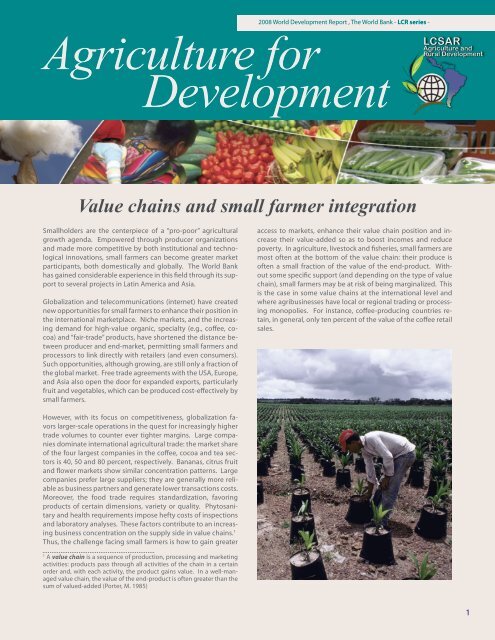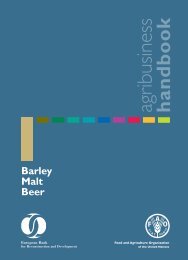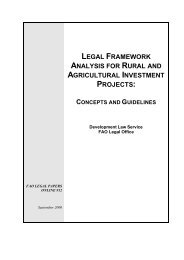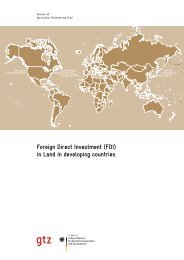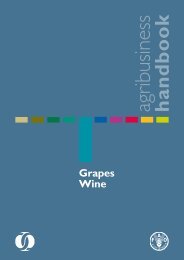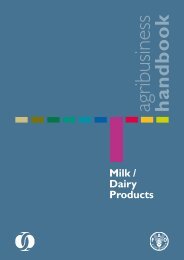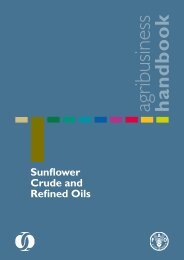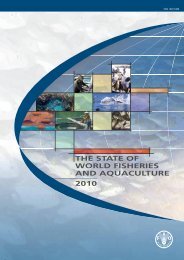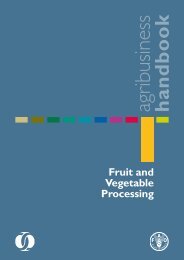Agriculture for Development- value chains small farmers.pdf
Agriculture for Development- value chains small farmers.pdf
Agriculture for Development- value chains small farmers.pdf
You also want an ePaper? Increase the reach of your titles
YUMPU automatically turns print PDFs into web optimized ePapers that Google loves.
2008 World <strong>Development</strong> Report , The World Bank - LCR series -<br />
<strong>Agriculture</strong> <strong>for</strong><br />
<strong>Development</strong><br />
LCSAR<br />
<strong>Agriculture</strong> and<br />
Rural <strong>Development</strong><br />
Value <strong>chains</strong> and <strong>small</strong> farmer integration<br />
Smallholders are the centerpiece of a “pro-poor” agricultural<br />
growth agenda. Empowered through producer organizations<br />
and made more competitive by both institutional and technological<br />
innovations, <strong>small</strong> <strong>farmers</strong> can become greater market<br />
participants, both domestically and globally. The World Bank<br />
has gained considerable experience in this field through its support<br />
to several projects in Latin America and Asia.<br />
Globalization and telecommunications (internet) have created<br />
new opportunities <strong>for</strong> <strong>small</strong> <strong>farmers</strong> to enhance their position in<br />
the international marketplace. Niche markets, and the increasing<br />
demand <strong>for</strong> high-<strong>value</strong> organic, specialty (e.g., coffee, cocoa)<br />
and “fair-trade” products, have shortened the distance between<br />
producer and end-market, permitting <strong>small</strong> <strong>farmers</strong> and<br />
processors to link directly with retailers (and even consumers).<br />
Such opportunities, although growing, are still only a fraction of<br />
the global market. Free trade agreements with the USA, Europe,<br />
and Asia also open the door <strong>for</strong> expanded exports, particularly<br />
fruit and vegetables, which can be produced cost-effectively by<br />
<strong>small</strong> <strong>farmers</strong>.<br />
access to markets, enhance their <strong>value</strong> chain position and increase<br />
their <strong>value</strong>-added so as to boost incomes and reduce<br />
poverty. In agriculture, livestock and fisheries, <strong>small</strong> <strong>farmers</strong> are<br />
most often at the bottom of the <strong>value</strong> chain: their produce is<br />
often a <strong>small</strong> fraction of the <strong>value</strong> of the end-product. Without<br />
some specific support (and depending on the type of <strong>value</strong><br />
chain), <strong>small</strong> <strong>farmers</strong> may be at risk of being marginalized. This<br />
is the case in some <strong>value</strong> <strong>chains</strong> at the international level and<br />
where agribusinesses have local or regional trading or processing<br />
monopolies. For instance, coffee-producing countries retain,<br />
in general, only ten percent of the <strong>value</strong> of the coffee retail<br />
sales.<br />
However, with its focus on competitiveness, globalization favors<br />
larger-scale operations in the quest <strong>for</strong> increasingly higher<br />
trade volumes to counter ever tighter margins. Large companies<br />
dominate international agricultural trade: the market share<br />
of the four largest companies in the coffee, cocoa and tea sectors<br />
is 40, 50 and 80 percent, respectively. Bananas, citrus fruit<br />
and flower markets show similar concentration patterns. Large<br />
companies prefer large suppliers; they are generally more reliable<br />
as business partners and generate lower transactions costs.<br />
Moreover, the food trade requires standardization, favoring<br />
products of certain dimensions, variety or quality. Phytosanitary<br />
and health requirements impose hefty costs of inspections<br />
and laboratory analyses. These factors contribute to an increasing<br />
business concentration on the supply side in <strong>value</strong> <strong>chains</strong>. 1<br />
Thus, the challenge facing <strong>small</strong> <strong>farmers</strong> is how to gain greater<br />
1<br />
A <strong>value</strong> chain is a sequence of production, processing and marketing<br />
activities: products pass through all activities of the chain in a certain<br />
order and, with each activity, the product gains <strong>value</strong>. In a well-managed<br />
<strong>value</strong> chain, the <strong>value</strong> of the end-product is often greater than the<br />
sum of <strong>value</strong>d-added (Porter, M. 1985)<br />
1
Integrate marketing and <strong>value</strong> chain aspects into existing<br />
extension systems: Extension services have traditionally focused<br />
on production aspects. Extension services that integrate<br />
marketing aspects are generally more successful in introducing<br />
productive changes on <strong>small</strong> farms. The Peru Irrigation Project<br />
has, since 1999, introduced a program focused on the marketing<br />
potential of the produce rather than on its productivity.<br />
Introduce and en<strong>for</strong>ce standard marketing contracts: Minimum<br />
standard contracts between <strong>small</strong> <strong>farmers</strong> and purchasing<br />
agents can build mutual trust and enhance their willingness<br />
to establish longer-term contract farming relationships.<br />
Linking <strong>small</strong> <strong>farmers</strong> to <strong>value</strong> <strong>chains</strong><br />
Policies to Enhance the Value Chain<br />
Position of Small Farmers<br />
The public sector can undertake the following policies to enhance<br />
<strong>small</strong> <strong>farmers</strong>’ integration in <strong>value</strong> <strong>chains</strong>:<br />
Improve infrastructure and telecom networks: Good roads,<br />
ports, airports and rail infrastructure as well as telecommunications<br />
reduce transport and intermediation costs and cut the distance<br />
between <strong>farmers</strong> and markets as has been demonstrated<br />
in the Peru Rural Roads Program. Phones and the internet (Nicaragua)<br />
increase access to market in<strong>for</strong>mation <strong>for</strong> remote, rural<br />
communities.<br />
The perishability of agricultural products requires careful handling,<br />
special facilities (e.g., packing, cold storage, and refrigerated<br />
transport) and rapid delivery to customers to maintain<br />
quality and reduce physical and nutritional losses. Government<br />
or municipalities can help reduce marketing costs in <strong>value</strong><br />
<strong>chains</strong> by investing in efficient wholesale markets, joint packing<br />
and refrigeration facilities at markets and airports. Such investments<br />
have a positive impact on domestic food prices eliminating<br />
marketing bottlenecks.<br />
Stimulate private market in<strong>for</strong>mation systems: Privatelymanaged<br />
in<strong>for</strong>mation systems have been shown to provide<br />
more relevant and up-to-date in<strong>for</strong>mation more cost effectively<br />
than public systems. For example, the wholesale market in Medellin,<br />
Colombia uses text messaging and the internet to in<strong>for</strong>m<br />
<strong>farmers</strong> about prices and marketed quantities. Such in<strong>for</strong>mation<br />
also serves as a reference in <strong>for</strong>ward or long-term marketing<br />
contracts.<br />
Promote commodity exchanges: The creation of commodity<br />
exchanges by trader (export) associations and farmer organizations<br />
(e.g., Dominican Republic-BOLSAGRO) expedites the participation<br />
of farmer associations in bulk commodities markets<br />
(e.g., cereals, tubers, export crops). Commodity exchanges have<br />
a price stabilizing effect, allowing farmer associations to hedge<br />
against price risk. Banks can use them as a credit collection<br />
mechanism.<br />
Urban markets, especially supermarkets, and export markets in<br />
LAC have become more sophisticated and now require higher<strong>value</strong>,<br />
higher-quality produce. Rising household incomes also<br />
favor consumption of high-<strong>value</strong> products (e.g., meats, fruit, and<br />
vegetables) and processed foods. Supermarkets -- heavily concentrated<br />
at the national level and sometimes <strong>for</strong>eign-owned<br />
(e.g., Wall-Mart, Carrefour) -- dominate food sales, capturing 50<br />
percent of the total LAC retail food market. Public policy to enhance<br />
<strong>small</strong> farmer participation in urban markets, supermarkets<br />
and commodity markets could include the following:<br />
Promoting partnerships between <strong>small</strong> producers and agrobusinesses<br />
or commodity wholesalers: Such partnerships – in<br />
which the commercial partner agrees to purchase the produce<br />
of <strong>small</strong> farmer organizations at a certain reference price and in<br />
accordance with agreed specifications – <strong>for</strong>malize <strong>value</strong> chain<br />
participation <strong>for</strong> <strong>small</strong> <strong>farmers</strong>, strengthen their business acumen<br />
and market orientation, develop their negotiation skills<br />
with the private sector and facilitate new market-driven technology<br />
adoption. Programs to promote such partnerships are<br />
under implementation in several LAC countries (Box 1). They<br />
generally contain a grant element to allow <strong>small</strong> <strong>farmers</strong> to<br />
adapt more easily to market requirements.<br />
Box 1. Colombia: Rural Productive Partnerships<br />
Project<br />
Productive Partnerships have been promoted in Colombia since<br />
2002. The Colombian Government provides grants to farmer associations<br />
to adapt their production technology to market demand,<br />
including <strong>for</strong> health and organic certifications. More than<br />
150 partnerships have been created in the oil palm, dairy, fruit,<br />
coffee, cocoa, cereals and domestic food sectors. Over the next<br />
five years another 300 partnerships are to be created. The partnerships<br />
have increased the revenue of the participating farmer<br />
families by more than 20 percent and employment by more than<br />
10 percent. Moreover, the project shows important multiplier effects<br />
on non participating <strong>farmers</strong> in the vicinity. This successful<br />
example is being followed in many other LAC countries and Asia:<br />
Panama, Peru, Bolivia, Honduras, Guatemala, and Vietnam. However,<br />
future challenges remain, such as establishing partnerships<br />
with supermarkets over an extended period of time.<br />
3<br />
www.lamayorista.com.co<br />
2
Help <strong>small</strong> <strong>farmers</strong> to comply with market standards and<br />
supermarket requirements: Supermarket or distribution center<br />
procurement systems differ from country to country and<br />
product type (e.g., centralized procurement, dedicated wholesalers,<br />
or direct contracting with processors and producers). All<br />
systems introduce specific standards regarding size, quality and<br />
product safety. In general, the systems favor asset-rich <strong>farmers</strong>.<br />
Supermarkets prefer to buy from larger <strong>farmers</strong> and/or <strong>farmers</strong><br />
with important assets such as: good road access, irrigation,<br />
green houses, vehicles and packing sheds. Farmers lacking such<br />
assets, particularly <strong>small</strong> <strong>farmers</strong>, are marginalized.<br />
Several countries (e.g., Colombia, Panama, Honduras, Guatemala,<br />
Dominican Republic, and Peru) have initiated or are implementing<br />
grant programs (sometimes combined with loans) to<br />
finance <strong>small</strong> farmer investments in drip irrigation, green houses<br />
and packing houses to facilitate their insertion into the <strong>value</strong><br />
<strong>chains</strong> of supermarkets, large wholesalers and exporters. Such<br />
programs are more successful where they are combined with<br />
technical assistance to enhance cooperation between <strong>small</strong><br />
<strong>farmers</strong>.<br />
Enhancing the management capacities of <strong>small</strong> farmer associations:<br />
The above measures will help <strong>small</strong> <strong>farmers</strong> to better<br />
integrate into the <strong>value</strong> chain and markets. Such integration<br />
will, however, be difficult without strong farmer associations<br />
and rural institutions that can support such associations.<br />
Acting alone, <strong>small</strong> <strong>farmers</strong> cannot produce the volumes necessary<br />
to satisfy buyers who want to reduce transaction costs,<br />
increase economies of scale and obtain a reliable supply. Only<br />
sufficiently large associations of <strong>small</strong> <strong>farmers</strong> can provide the<br />
quantities required by the domestic and international markets<br />
(Box 2). Moreover, to obtain a larger part of the <strong>value</strong> added in<br />
the <strong>value</strong> chain, producers have to gain bargaining power with<br />
the commercial private sector. Such bargaining power can only<br />
be obtained sustainably by organizing, and producing in both<br />
volume and quality.<br />
Box 2. Guatemala: Cooperative Cuatro<br />
Pinos<br />
The Guatemalan Cooperative Cuatro Pinos (Sacatepequez -Guatemala)<br />
represents more than 4,000 <strong>small</strong> <strong>farmers</strong> across 120 associations.<br />
Specializing in thirteen fruit and vegetable products (e.g.,<br />
French beans and peas), Cuatro Pinos functions as a purchasing,<br />
packing and refrigeration station and imposes rigorous quality<br />
standards on its suppliers. Such large cooperatives (which really<br />
operate as businesses) can reliably provide export markets with<br />
produce that complies with SPS and other standards.<br />
Governments have an important role to play by making it easier<br />
<strong>for</strong> <strong>farmers</strong> to legally <strong>for</strong>m associations, by introducing the<br />
“rules of the game” in terms of transparency and accountability<br />
and through capacity-building programs. But an even larger<br />
role belongs to the producer organizations (gremios) and NGOs<br />
in providing institutional support to the emerging and existing<br />
associations. The field is wide open: (1) helping the associations<br />
4<br />
The old co-operative principle of “one person, one vote” is not conducive<br />
to successful business practices.<br />
with resolving the conflicts between business efficiency and equity<br />
and dealing with their heterogeneous memberships; 4 (2)<br />
financing training and capacity building <strong>for</strong> association managers;<br />
and (3) accompanying the associations over long periods to<br />
develop into viable businesses.<br />
Sanitary and phytosanitary standards<br />
and their costs<br />
Sanitary and phytosanitary standards (SPS) govern international<br />
trade to address food safety and health risks associated<br />
with pests (e.g., fruit flies), food-borne and zoonotic diseases<br />
(e.g., foot-and-mouth disease, mad-cow disease) and microbial<br />
pathogens and other contaminants (e.g., mycotoxins, pesticides).<br />
These standards vary widely across countries. The capacities<br />
of governments and <strong>farmers</strong> to deal with these standards<br />
also differ widely.<br />
Many governments and private sector actors have introduced<br />
additional standards related to the environment, social management<br />
(e.g., child labor) and commercial aspects. Moreover<br />
several importing countries have introduced traceability and<br />
certification requirements. The up-front cost to <strong>small</strong> <strong>farmers</strong><br />
of compliance with these multiple standards and traceability<br />
requirements (including inspection systems – <strong>for</strong> instance mangos<br />
in Haiti) can be substantial, while the markets often remain<br />
quite volatile. The benefits in terms of productivity, environmental<br />
protection, reduced wastage and competitiveness are<br />
rather long-term. Local consumers may also benefit.<br />
Both the public and private sector have a role to play in facing<br />
SPS and other quality management challenges. The public<br />
sector can: (1) adopt food safety legislation and standards consistent<br />
with local conditions and preferences, WTO and other<br />
trade obligations; (2) strengthen the domestic systems <strong>for</strong> pest,<br />
animal disease and market surveillance; (3) support research on<br />
food safety and agricultural health; (4) promote good practices<br />
through extension programs; (5) invest in laboratory infrastructure<br />
or accredit private laboratories; and (6) improve water and<br />
sanitation and market facilities.<br />
3
The private sector can: (1) implement appropriate management<br />
practices – obtaining certification where necessary; (2) adopt<br />
systems to enable produce traceability; (3) develop training, advisory<br />
and con<strong>for</strong>mity assessment services to assist <strong>farmers</strong> and<br />
exporters to comply with the requirements; and (4) introduce<br />
collective action and self-regulation through adoption of codes<br />
of practice and alert governments to emerging issues.<br />
Extending and Deepening Rural<br />
Financial Services<br />
Relatively higher transactions costs, lower population density,<br />
and increased risk premiums vis-à-vis the urban sector have<br />
historically blunted expansion of financial services to the rural<br />
sector, particularly <strong>small</strong> <strong>farmers</strong>. In rural Honduras, Nicaragua<br />
and Peru, the credit-constrained population constitutes 40 percent<br />
of all agricultural producers; compared to unconstrained<br />
producers, they use only 50 to 70 percent of the purchased inputs<br />
and earn only 60 to 90 percent as much net income (Fig.<br />
1). Smallholders are asset-poor and “risk-rationed”—unwilling<br />
to risk <strong>for</strong>feiture of their already limited asset base. Weather risk<br />
further reduces the attractiveness of lending to <strong>small</strong>holders,<br />
particularly in the absence of developed insurance markets.<br />
Rural Finance Institutions (RFIs) can leverage social capital and<br />
peer monitoring in both stimulating and deepening rural financial<br />
markets. Using a <strong>value</strong>-chain approach, FUNDEA in Guatemala<br />
finances inputs and outputs <strong>for</strong> <strong>small</strong> <strong>farmers</strong>, accepting<br />
standing crops as collateral. Furthermore, public policy can<br />
support pilot testing of technological innovations that reduce<br />
costs and risks of offering financial instruments to rural <strong>small</strong>scale<br />
producers. Just as cellular phones can speed market and<br />
price in<strong>for</strong>mation to producers, so-called “mobile or m-banking”,<br />
now being piloted in Brazil, can also dramatically reduce<br />
transactions costs <strong>for</strong> rural financial transactions.<br />
Where necessary, financial regulations should be re<strong>for</strong>med to<br />
remove interest rate ceilings and permit RFIs to mobilize savings<br />
deposits, perhaps via branchless banking, taking advantage<br />
of existing post offices, gas stations and other retail outlets<br />
as conduits <strong>for</strong> rural financial transactions. Stimulating data collection<br />
via credit-reporting bureaus can also reduce the current<br />
risk premium associated with rural lending, due to in<strong>for</strong>mation<br />
deficits to gauge behavioral risk of potential borrowers. Rural<br />
finance <strong>for</strong> <strong>small</strong>holders would also benefit from the creation<br />
and expansion of insurance instruments to protect against losses.<br />
Weather-indexed insurance shows promise in taking advantage<br />
of climatic data on rainfall and temperature to calculate<br />
payout amounts.<br />
Fig. 1. Effects of credit constraints on<br />
agricultural producers<br />
References<br />
Adapted from the World <strong>Development</strong> Report 2008 <strong>Agriculture</strong> <strong>for</strong> <strong>Development</strong><br />
with additional in<strong>for</strong>mation from regional studies and anecdotal<br />
evidences.<br />
About the Authors<br />
Edward Bresnyan is a Senior Rural <strong>Development</strong> Economist and Pierre<br />
Werbrouck a Consultant with the World Bank’s Latin America and the<br />
Caribbean Region Agricultural and Rural <strong>Development</strong> Unit<br />
Latin America and the Caribbean Region<br />
The 2008 World <strong>Development</strong> Report (WDR) “<strong>Agriculture</strong> <strong>for</strong> <strong>Development</strong>” characterizes agriculture as vital development tool <strong>for</strong><br />
achieving the Millennium <strong>Development</strong> Goal that calls <strong>for</strong> halving by 2015 the share of people suffering from extreme poverty and<br />
hunger. The report provides guidance to governments and the international community on designing and implementing agriculture<strong>for</strong>-development<br />
agendas that can make a difference in the lives of hundreds of millions of rural poor. This brief is part of a series<br />
prepared by LCSAR that summarizes and interprets the principal messages of the WDR 2008 and discusses region-specific implications<br />
<strong>for</strong> Latin America and the Caribbean (LCR). The series comprises the following topics: (i) Agricultural Innovations in Science and<br />
Technology, (ii) Value Chain <strong>Development</strong> and Integration of Small Farmers, (iii) Agricultural Trade Policy, (iv) Land Administration and<br />
Access, and (v) Territorial <strong>Development</strong>.<br />
4


